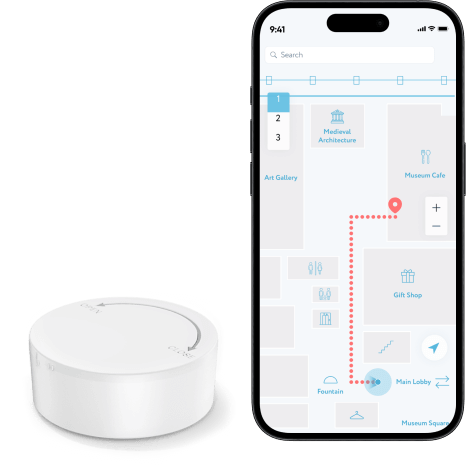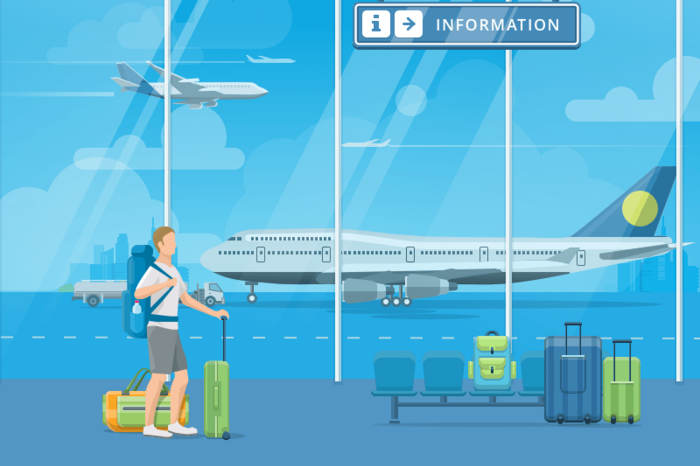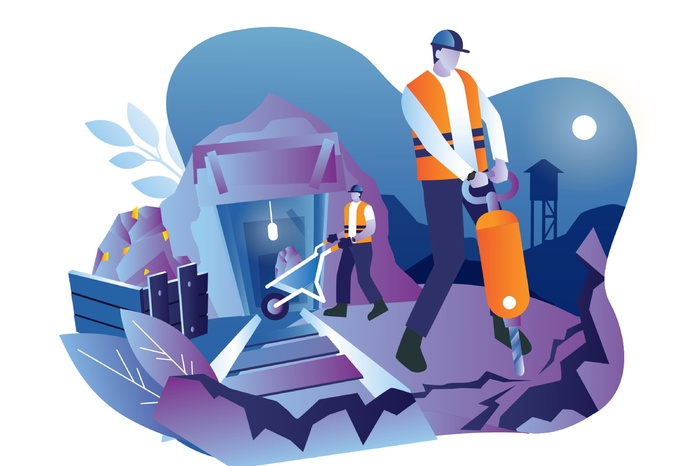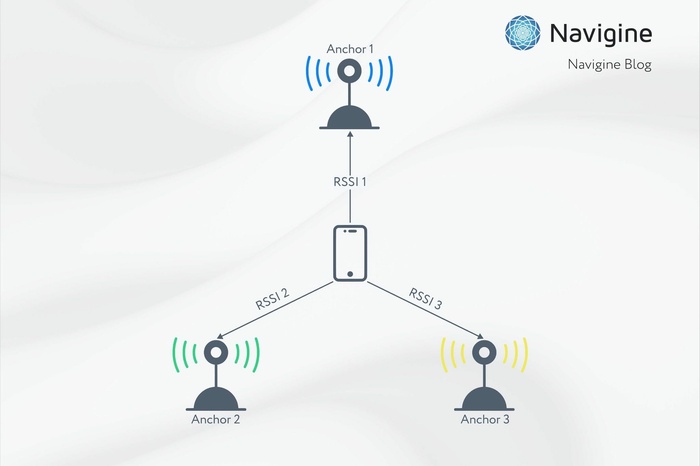The beacon technology is a promising development from Apple intended for transmitting Bluetooth® signals to devices located within the range of beacons. Thus, there is a possibility of locating objects in the building. The main operating principle is in setting up tiny beacons that are connected to users’ smartphones using the Bluetooth Low Energy standard.
Beacon technology allows programming different actions depending on the received identifier and the distance from the smartphone to the beacon. The mobile phone application tracks objects and persons, builds interactive maps, and displays informational and promotional push notifications. Such an approach significantly simplifies communication between companies and consumers and provides businessmen with an effective tool for attracting targeted audiences.
Key Takeaways
- iBeacon technology enables precise location tracking and indoor navigation, making it valuable for various industries.
- iBeacons consume 30 times less energy than Wi-Fi, allowing for long battery life.
- iBeacon technology consists of beacons, Bluetooth communication, and mobile applications for indoor positioning.
- iBeacons enhance navigation and user experience in buildings, providing interactive maps and logistics simplification.
- iBeacons enable targeted personalized notifications based on location, driving customer engagement and sales.
- Implementing iBeacon has advantages such as low costs, scalability, and data collection, but also disadvantages like the need for a dedicated app and possible user rejection.
Bluetooth® LE standard
The Bluetooth® Low Energy standard is a wireless technology ensuring low energy consumption for smartphones. While working with iBeacons, users’ mobile devices consume 30 times less energy than in the case of connecting via Wi-Fi. Every beacon can function on one battery for more than a year. The Bluetooth® LE protocol works at a distance of up to 50-70 m (depending on the characteristics of the terrain). The average channel speed of the standard for mobile apps is up to 0.27 Mb/sec.
How does iBeacon work?
The beacons can be installed anywhere within the building or on moving objects. Signals from sensors contain a common UUID and a personal code for the beacon, which allows the system to distinguish it from other devices in the vicinity. The program also receives information about the signal transmission power, which allows you to estimate the distance from the transmitter to the reading device.
The readers receive radio pulses from the beacons and send them to the server, where they are processed to determine the exact coordinates of the sensor. The final data is transferred to a smartphone where the mobile application is already installed.
The beacon technology consists of three mutually dependent components:
- iBeacon hardware (Bluetooth® beacons) - installed on the perimeter of the building, it sends signals at intervals of a fraction of a second.
- Bluetooth® - a wireless communication standard that provides information exchange between the beacon and the mobile device.
- Mobile beacons applications with the integrated Navigine SDK component - a program with indoor positioning technology developed for certain businesses. To get information, the user has to install the application on his phone.
Main iBeacon use cases
The usage of iBeacon trackers presupposes three different cases.
Navigation
Beacons can be installed in different places to simplify logistics around the building. They are used in shopping centers, exhibitions, and medical institutions, museums, libraries, industrial enterprises. The iBeacon indoor mapping function helps to lead a person literally by the hand and show him the places of interest. Thus, in shops, it can build a route to the necessary shelf or goods, and in the library – to the wanted book. Beacons technology helps to make an interactive map, develops the best route, allows visitors or staff to get to the place using the quickest way. All these things improve user experience and make them more loyal to the given company.
Learn more about navigation in the article - https://navigine.com/blog/using-ble-for-indoor-navigation-and-positioning/
Indoor Navigation and Wayfinding BLE Kit - Minew Hardware
Try all location-powered capabilities with the Navigine Indoor Indoor Navigation and Wayfinding BLE Kit - Minew Hardware
Purchase
Marketing
Every year proximity marketing is becoming more and more common, especially in trading, which allows retailers to apply an individual approach to every customer. Beacons let users get any necessary information in the form of notifications about actions, discounts, new goods, or tips with detailed information about products or services. When using the beacons technology, marketers can send relevant content to clients and target advertising, improving marketing campaigns.
With the help of indoor location using Bluetooth® proximity beacons, visitors of shops can be provided with route maps around the shop that show them the quickest and simplest way to promotional goods. Building interactive online maps with points of interest increase clients’ loyalty and encourages them to come back. Thanks to iBeacon navigation, customers can save their time and quickly find the places or departments that are interesting to them. Thus, the retailer improves the user experience of customers and attracts new clients to the shop.
As an example of proximity marketing, let’s look at the case from Navigine developed for the network of Finnish supermarkets. The basis of the development is an individual shopping guide that looks like a shopping trolley with a tablet. The client just has to take a trolley, upload the list of necessary products or the name of the required dish. The system immediately provides him with the recipe and builds the route around the supermarket indicating the location of the needed goods.
Analytics
After the emergence of iBeacon technology, it has become easier for businessmen to analyze clients’ logistics and understand their main requests. Using the technology, it’s possible to create flow maps, divide visitors into one-time and regular clients, get heatmaps, define sources of traffic. In industrial enterprises, the system is useful due to its options for making effective management decisions. Managers can track valuable assets and production units, record lateness, regulate task scheduling. As a result, the company gets considerable cost reduction and improvement in workplace safety.
iBeacon in various industries
The function of exact iBeacon positioning can be applied in many spheres:
- Shopping malls. iBeacon technology helps customers quickly find convenient routes to stores or specific products, which increases their loyalty to the company. The management can also use technology as an effective marketing channel. Based on geolocation, notifications get sent to visitors, which may contain advertising messages, information about discounts and promotions, or product recommendations.
- Colleges. iBeacon technology improves the convenience of students, teachers, and visitors in terms of moving around the facility. The iBeacon-based system allows you to create a shortcut to an office or classroom, track valuable assets (such as laptops, projectors, etc.), and also distribute information related to the college schedule or workflow.
- Museums. iBeacon monitoring provides a better visitor experience. Now, it’s easier to find specific halls or exhibits and obtain information about objects of interest. The system can be effectively used to create digital maps and mini-tours or to provide visitors with relevant content about upcoming events.
- Healthcare. In healthcare, the system makes it easier to navigate hospitals and track the movements of patients or valuable medical equipment. Using iBeacon technology, you can quickly find doctors’ offices or treatment rooms, and perform visual traffic analytics to identify bottlenecks. iBeacon also allows medical staff to monitor patients with dementia, sclerosis, and other similar disorders who tend to wander.
- Entertainment and culture. iBeacon technology simplifies managing exhibitions, conferences, and other events. Using the iBeacon-based platform, you can manage visitor flows, find stands of interest, and send useful data or personalized advertising.
Advantages and disadvantages of iBeacon technology
Like any other smart solution, iBeacon technology has its pluses and minuses. Let’s consider them in detail.
Advantages of beacon technology
The key advantages of using this type of radio-frequency technology are the following:
- Low realization costs. Modern beacons are made from available materials and their batteries can ensure an uninterrupted power supply within 5 years. Thus, these devices are considered more cost-effective than other RTLS sensors.
- Wide coverage of the audience. Bluetooth® is supported by all modern smartphones. Installing the mobile application on the phone is enough to take advantage of all the possibilities of the system.
- Scalability and reliability. Beacons do not require a direct signal from the satellite since it happens with GPS so they work effectively both outside and inside, including in buildings with thick walls or on the underground floors. Some models are protected from external influences so they are not afraid of rain or temperature fluctuations.
- The simplicity of implementation and realization. Most platforms based on the beaconing technology can be easily deployed and customized to the client’s needs. Practically all solutions are delivered together with the necessary software, which significantly simplifies their integration into the existing infrastructure of the enterprise.
- Personal user experience. When using the ibeacon tracking technology, users can get individual notifications with useful information or advertisements. The system allows sending out notifications not only to the clients inside buildings but also to those passing by.
- Extended data collection. iBeacon provides detailed analytics about the company’s performance, which allows for optimizing its activity for increasing profits.
Disadvantages of beacons technology
Despite all the advantages, iBeacons indoor positioning technologies have some disadvantages, which have to be considered during the implementation. They are not able to have a significant impact on the general system performance but require the attention of business representatives. iBeacon minuses are the following:
- Obligatory presence of the mobile app. In most cases, the system works only with the mobile app that is developed especially under a specific company. Sometimes developers manage to apply for third-party programs, however, for attracting users and ensuring business continuity it’s advisable to use your own application for smartphones.
- Likelihood of users’ rejection. To use all the options of the system, it is necessary to have the permission of smartphone users. In such situations, business representatives periodically face users’ rejections. The reason is in large volumes of content are sent daily to their phones. Not all people like getting many advertising notifications, so they just switch off Bluetooth®.
- Difficulties in beacon software development. The technology is easily realized in the marketing, retail, and hospitality industry. However, certain difficulties requiring professional assistance can appear while applying this technology in other spheres. The technical side of the question can take much time, especially if it concerns large enterprises that need scalable solutions.
Myths on iBeacon
Although the iBeacon technology has appeared recently, there are many myths around it. Let’s look at the most common misconceptions which will clarify the insight into the system:
- iBeacon works only with iPhones. For receiving radio signals from beacons, mobile devices use the Bluetooth® LE technology, i.e. beacons can be recognized by any equipment with Bluetooth® Low Energy support and equipped with an OS older than Android 4.3 or iOS 7.0.
- iBeacon tracks users. The technology can’t control mobile device users. The beacon just sends signals and mobile apps can detect them and execute certain actions. But only if the user has installed the app and chosen the relevant parameters in the settings.
- Because of iBeacon, a mobile phone battery runs out very quickly. For receiving radio signals, mobile devices use the Bluetooth® LE technology, so the system practically does not affect battery consumption.
- iBeacon defines the exact location of a person. The range of beacon signals is up to 70 m. The main advantage of the system is not the establishment of the exact location but the ability to define the proximity of the user to some object. The iBeacon accuracy of radio beacons depends on the distance. If the user is 10 m from the beacon, the accuracy can be up to 2 m, if the distance is 20 sm, the accuracy is about 6 sm.
- iBeacon sends information. Beacons don’t transmit any content. They just send signals that allow the mobile application to send out notifications. All information comes to the phone from the server, not via iBeacon. For that, the user has to be within the range of the beacon.
- iBeacon can be used only inside the building. The iBeacon network is successfully applied inside and outside buildings. The manufacturers of the equipment constantly produce new versions of beacons that can work in the open air, even in bad weather.
Comparison of iBeacon and Eddystone technologies
The beacons technology has an analog, Eddystone, developed by Google. For choosing the most suitable platform for delivering content, it’s necessary to understand the main working principles of these systems, evaluate their advantages and disadvantages.
Many people think that Eddystone and iBeacon are completely different systems but actually, both systems can send information on object location to the mobile device and Bluetooth® beacons can follow each of the mentioned protocols. Let’s compare the given technologies and consider their differences:
- iBeacon belongs to closed-type platforms while Eddystone is an open type, i.e. developers can change the code and introduce modifications.
- iBeacon was originally developed for iOS, but it is compatible not only with this system but also with Android. The other platform is compatible with all operating systems that support the Bluetooth® LE function.
- iBeacon has no special APIs for its beacons. Eddystone can work only with Bluetooth® API for iOS or Android.
- iBeacon has a simple codebase; its competitor’s architecture is more complicated.
- To open the URL received from the radio beacon, Eddystone needs a browser. A special mobile application is used for displaying the information from UUID from the beacons for indoor positioning.
FUTURE OF INDOOR POSITIONING WITH IBEACON
Experts claim that iBeacon technology will penetrate into all spheres of life. According to Verified Market Research, in 2027 the market for the technology will reach more than 109532.21 Million US dollars, with a growth rate of 87.74% from 2020 to 2027. The system opens up unlimited opportunities for businesses in the sphere of development and organizing marketing campaigns. Using this technology, companies can track objects inside buildings, get detailed analytics of enterprises, define the needs of clients, and send out targeted advertisements.
Originally, the technology was aimed at retail but after spreading, it started to be used in industry, logistics, culture, and healthcare. Over the course of time, iBeacon advantages will be evaluated also by other sectors of the economy, which will entail the installation of beacons in many business objects.
Specialists do not see any restrictions for implementing the technology into the company infrastructure. Beacons are not expensive, they are easily customized to the enterprise’s needs and iBeacon application allows for optimizing business processes and increasing profits. Thus, the system has every chance for further development and easy implementation in many other sectors of the economy.
Navigine offers users an effective B2B platform for developing applications based on iBeacon. The basis of the development is the iBeacon technology which opens endless possibilities for developing business in any sphere – from manufacturing and logistics to healthcare, retail and digital advertising.
Ready to unleash the power of iBeacon? Contact us today for a free consultation and learn how this innovative technology can transform your business operations and customer experience!



